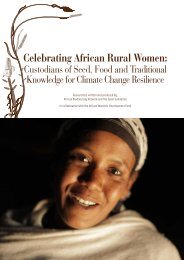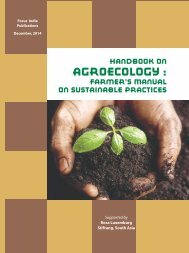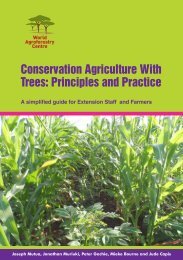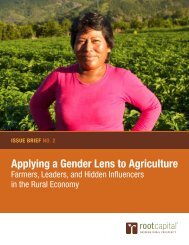1t0SC7l
1t0SC7l
1t0SC7l
You also want an ePaper? Increase the reach of your titles
YUMPU automatically turns print PDFs into web optimized ePapers that Google loves.
soil, result in loss of soil aggregates stability (see Section 3.3.2) and soil structure, which in turn<br />
results in soil compaction, increased bulk density and decreased infiltration rate and water<br />
holding capacity of the soil. This leads to an increase in overland flow and further increase in<br />
erosion and degradation of topsoil. The practice of tillage also destroys the topsoil thin (3-5 cm)<br />
A 1 organic horizon, which is present under the virgin forest (see Section 4.3.1). This A 1 horizon<br />
is humic, very rich in fine roots, very friable, very porous, with granular subangular structure<br />
induced by a network of fine roots. It is within this A 1 horizon that farmers plant with zerotillage,<br />
cucumber (Cucumeropsis mannii) and maize (Zea mays) seeds when they clear an old<br />
forest.<br />
Erosion. The accelerated erosion is considered as man-induced erosion. The change of the soil<br />
chemical and physical properties under land cropping leads to an increased soil loss hazard due to<br />
detachment and transportation. In general, agricultural land in the study area are mostly located in<br />
dissected plains and rolling uplands landform units (van Gemerden and Hazeu, 1999) where the<br />
existing gentle slopes limit the effects of soil erosion processes. This partially explains the low<br />
sediment yields in the rivers reported by Waterloo et al. (2000). However, the soil type and the<br />
cropping systems / farming systems are the most important factors affecting erosion hazard<br />
variation in the area. From our field observation in the study area, sheet erosion occurs under the<br />
impact of the early rains at the beginning of the cropping period in annual crop fields. The<br />
consequence of this erosion is the rapid deterioration of the physical condition of the soil surface<br />
and leaching of nutrients from ashes. This process is lessened when the first crops cover the<br />
ground. When the first crop has been harvested, the soil surface is again exposed to some extent,<br />
but intercrops, weeds and the residues from the harvest provide some protection.<br />
Soil fauna. Soil micro-organisms together with soil macrofauna act as agents of nutrient cycling<br />
by regulating the retention and flux of nutrients in the soil system through processes of<br />
decomposition, mineralisation and immobilisation. Soil micro-organisms also enhance the<br />
amount and efficiency of nutrient acquisition by plants through the role of plant symbionts such<br />
as mycorrhiza and nitrogen fixing bacteria (see also Onguene, 2000). These functional<br />
relationships might be most evident in the natural ecosystems but also play a key role in<br />
determining the productivity and sustainability of agricultural systems. The activity of soil<br />
microbiota can be measured by what is called ‘microbial biomass’. This aspect should not be left<br />
out when one is to deem thoroughly the effect of shifting cultivation on soil degradation.<br />
Other factors<br />
Weeds, diseases, pests and insects. Weed growth is often of profound hindrance to crop<br />
production in tropical agriculture. Weed competition to crops is considered a factor that limits the<br />
effectiveness of soil available nutrients in increasing crop yields. However, weeds invasion has a<br />
positive effect as soil cover and protect soil against high erosive rainfall. Nematode and insect<br />
fauna and pathogenic microbes are also diverse in the tropics. High population of these parasite<br />
species often cause significant damage to crops. The parasite population, which might have built<br />
up during the cropping phase, is likely to be greatly reduced in numbers after several years of<br />
fallow.<br />
Phytomass reduction. In selecting a site for clearing, shifting cultivators, in general, judge the<br />
suitability of a prospective cropping site on the basis of existing vegetation rather than on soil<br />
characteristics (see Tables 2.11 and 2.15). In the study area, soils are classified in general lower<br />
chemical fertility levels (van Gemerden and Hazeu, 1999). A large part of nutrients is stored in<br />
the phytomass (vegetation biomass). The mature forest has adapted to the low nutrient level of<br />
soil by maintaining an almost closed nutrient cycle. Through recycling, these nutrient stocks<br />
44








